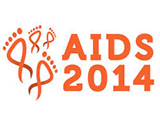 AbbVie’s “3D” regimen has shown high cure rates in treating genotype 1 of hepatitis C virus (HCV) among those coinfected with HIV, both with and without cirrhosis, aidsmap reports. Interim findings from the randomized, open-label TURQUOISE-I study of 12 or 24 weeks of the regimen were presented at the 20th International AIDS Conference (AIDS 2014) in Melbourne, Australia.
AbbVie’s “3D” regimen has shown high cure rates in treating genotype 1 of hepatitis C virus (HCV) among those coinfected with HIV, both with and without cirrhosis, aidsmap reports. Interim findings from the randomized, open-label TURQUOISE-I study of 12 or 24 weeks of the regimen were presented at the 20th International AIDS Conference (AIDS 2014) in Melbourne, Australia.
A total of 63 HIV-positive participants who had genotype 1 of hep C were evenly divided to receive the 3D regimen for 12 or 24 weeks. The 3D regimen consists of the fixed-dose combination of the protease inhibitor ABT-450 and ritonavir co-formulated with the NS5A inhibitor ombitasvir (ABT-267), as well the non-nucleoside polymerase inhibitor dasabuvir (ABT-333), either with or without ribavirin (in this case ribavirin was used).
Ninety-four percent of those in the 12-week group achieved a sustained virologic response 12 weeks after completing therapy (SVR12, considered a cure). Not all of those in the 24-week arm have yet made it 12 weeks past finishing therapy. Ninety-seven percent of them achieved an SVR4, which is a strong predictor of an ultimate cure. Out of 20 participants in this arm who did pass the 12-week mark post-therapy, 95 percent of them had achieved an SVR12.
All the participants had a suppressed HIV viral load and were taking an antiretroviral regimen including Reyataz (atazanavir) or Isentress (raltegravir). Safety testing before the study had shown that there are no adverse drug-drug interactions between those drugs or Truvada (tenofovir/emtricitabine) and the 3D regimen. The ritonavir in the hep C regimen does act as a booster for Reyataz.
The 3D regimen proved generally safe and well tolerated. There were no serious side effects or discontinuations as a result of side effects. The most common included fatigue, insomnia, nausea and headache, most of which were mild or moderate.
To read the aidsmap story, click here.
To read the conference abstract, click here.
Advertisement
Advertisement
Advertisement






Comments
Comments